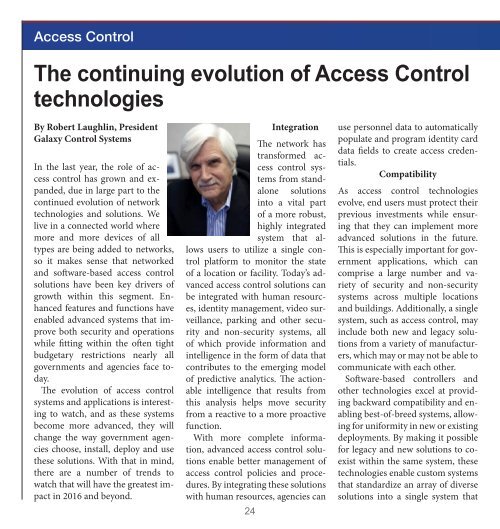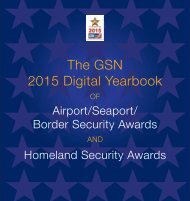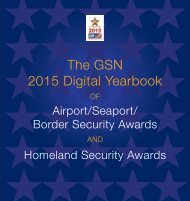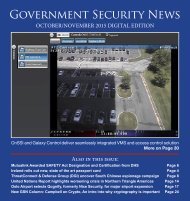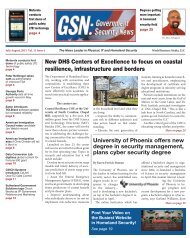GSN January 2016 Digital Edition
Create successful ePaper yourself
Turn your PDF publications into a flip-book with our unique Google optimized e-Paper software.
Access Control<br />
The continuing evolution of Access Control<br />
technologies<br />
By Robert Laughlin, President<br />
Galaxy Control Systems<br />
In the last year, the role of access<br />
control has grown and expanded,<br />
due in large part to the<br />
continued evolution of network<br />
technologies and solutions. We<br />
live in a connected world where<br />
more and more devices of all<br />
types are being added to networks,<br />
so it makes sense that networked<br />
and software-based access control<br />
solutions have been key drivers of<br />
growth within this segment. Enhanced<br />
features and functions have<br />
enabled advanced systems that improve<br />
both security and operations<br />
while fitting within the often tight<br />
budgetary restrictions nearly all<br />
governments and agencies face today.<br />
The evolution of access control<br />
systems and applications is interesting<br />
to watch, and as these systems<br />
become more advanced, they will<br />
change the way government agencies<br />
choose, install, deploy and use<br />
these solutions. With that in mind,<br />
there are a number of trends to<br />
watch that will have the greatest impact<br />
in <strong>2016</strong> and beyond.<br />
24<br />
Integration<br />
The network has<br />
transformed access<br />
control systems<br />
from standalone<br />
solutions<br />
into a vital part<br />
of a more robust,<br />
highly integrated<br />
system that allows<br />
users to utilize a single control<br />
platform to monitor the state<br />
of a location or facility. Today’s advanced<br />
access control solutions can<br />
be integrated with human resources,<br />
identity management, video surveillance,<br />
parking and other security<br />
and non-security systems, all<br />
of which provide information and<br />
intelligence in the form of data that<br />
contributes to the emerging model<br />
of predictive analytics. The actionable<br />
intelligence that results from<br />
this analysis helps move security<br />
from a reactive to a more proactive<br />
function.<br />
With more complete information,<br />
advanced access control solutions<br />
enable better management of<br />
access control policies and procedures.<br />
By integrating these solutions<br />
with human resources, agencies can<br />
use personnel data to automatically<br />
populate and program identity card<br />
data fields to create access credentials.<br />
Compatibility<br />
As access control technologies<br />
evolve, end users must protect their<br />
previous investments while ensuring<br />
that they can implement more<br />
advanced solutions in the future.<br />
This is especially important for government<br />
applications, which can<br />
comprise a large number and variety<br />
of security and non-security<br />
systems across multiple locations<br />
and buildings. Additionally, a single<br />
system, such as access control, may<br />
include both new and legacy solutions<br />
from a variety of manufacturers,<br />
which may or may not be able to<br />
communicate with each other.<br />
Software-based controllers and<br />
other technologies excel at providing<br />
backward compatibility and enabling<br />
best-of-breed systems, allowing<br />
for uniformity in new or existing<br />
deployments. By making it possible<br />
for legacy and new solutions to coexist<br />
within the same system, these<br />
technologies enable custom systems<br />
that standardize an array of diverse<br />
solutions into a single system that


